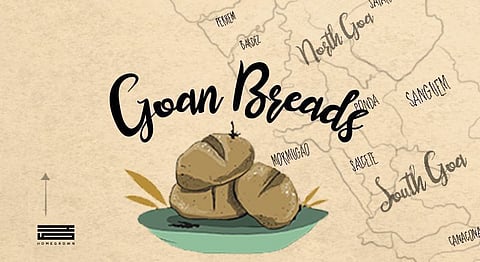
- HOMEGROWN WORLD
- #HGCREATORS
- #HGEXPLORE
- #HGVOICES
- #HGSHOP
- CAREERS
- ABOUT US
- CONTACT US

Most people associate the crack of dawn with the rooster’s call –– a sound that lays somewhere between a cluck and a crow. In Goa, this call follows the sound of the Poder, the carrier of bread –– a sign that a new day has dawned. The word Poder itself is derived from the Portuguese word for baker, Padeiro, ascertaining the cultural heritage of this bread.
It all dates back to the 1550s, according to this Indian Express report. “The Jesuits, who were part of the Salcete sub-district, one of the “old conquests” by the Portuguese in Goa, passed on the art of baking bread to the new Christian converts.” According to Cozinha de Goa, ‘History and Tradition of Goan Food’ authored by Fatima da Silva Gracias, the members of the Chardo caste of Majorda in Salcete, an area rife with plucky palm groves, helped produce the key ingredient, sur or toddy, that made the Goan bread “rise and shine like no other.”
For those who have broken through the crust to hear a symphony of crackle, or woken up extra early on vacation just to catch their neighbourhood Poder, gratefulness falls short. It’s this method of fermentation that sets this region’s bread apart from the rest of the country.
One glance into the Poder’s basket, and you’re sure to find a variety of bread –– each one a culinary delight of its own, never weighed down by its colonial history. It is to be noted that each area of Goa has its own poder who follows a distinct, never-changing route on a daily basis. However, it is increasingly difficult to find authentic local bread in Goa today, says Mr. Peter Dalima, the President of the Goan Bread Association. “Toddy (the main ingredient used for fermentation) has gone up from Rs. 30 per litre to Rs. 120 per litre –– making it very expensive for the local poder to acquire. Today, a lot of bakers use commercial yeast instead,” he tells us.
Today, there are less than 25 bakers in Goa who bake bread the way it was meant to be. We broke down the different types of popular local breads from the region for when you luck out and find yourself in the midst of a traditional, authentic Goan bakery. Word of advice? Your best bet is to hit the Margao Market!
Pao
This semi-soft square-shaped bread is an eternal favourite of all –– its crusty, golden crunch providing the closest alternative to the western ‘dinner roll’. It’s best eaten with chorizo and cutlet wedged in between the airy, white innards –– making for a perfect breakfast accompaniment, while also making for the perfect accompaniment to the ros omelette.
Poi
This bread is most similar to a pita pocket. It is typically flatter than the others, and has a wheat bran outer layer. As it rises, it forms a hollow cavity within it that is ideal for stuffing with goan sausage. It is made out of a mixture of whole wheat and white flour, and is slightly chewy in texture, as reported here. Poie and chicken cafreal is a culinary match made in culinary heaven –– there’s no going wrong with this combination.
Katro Pao
This bread gets its name from the Konkani word, kator, for the tool used to give it its shape –– the scissor. While being rolled out, the scissor is used with crisp hand movements that mould the dough. The katro pao is easily identified by its distinctive shape –– round, but cut on both sides, quite like a butterfly. In the Poder’s oven, this bread takes about 5 minutes to bake.
Kankon Pao
It is believed that this bread gets its name from the word for bangle, kankan, and of course, its shape resembles this lineage. It is typically a hard, ring-shaped bread with slight cracks on its crust. This is a sign of it being baked to its optimum capacity –– one crack away from being inedible. This bread is devoured with a cup of tea, glazed with a dollop of butter, and cream cheese if you’re feeling a particular indulgence.
Undo
This bread is highly distinctive given its obvious round shape, and the brittle crust which falls apart (the result of baking it at low temperatures) as you sink your teeth into the bread. The insides remain soft and fluffy, championing it to be the most commonly used bread for the mighty Goan cutlet pao.
All illustrations by Anjul Dandekar.
If you liked reading this, you may also like:
